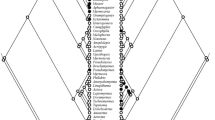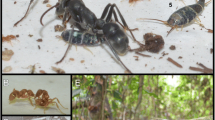Abstract
The exchange of rapid antennal strikes between individuals is a behavior exhibited by many social hymenopterans, largely in dominance contexts within the nest and in aggressive contexts towards non-nestmates. Despite being widely reported, the behavior itself has not been well described or compared between species for the majority of social insect groups. We first document how often rapid antennation is used as an aggressive response to non-nestmates for four species of Odontomachus ants. We then use high-speed videography to measure the rate of rapid antennation behavior for these species. We find that rates are neither conserved nor species-specific and average between 19.5 and 41.5 strikes/s. Next, with O. brunneus, we compare this behavior as it is performed between nestmates and non-nestmates. We find no context-specific differences in rate, bout length, or number of strikes. We conclude by discussing the evolution of this behavior and its potential utility as a model for understanding aggressive behaviors both inside and outside of the nest.


Similar content being viewed by others
References
Balas MT, Adams ES (1996) Nestmate discrimination and competition in incipient colonies of fire ants. Anim Behav 51:49–59
Bonavita-Cougourdan A, Morel L (1984) Les activities antennaires as cours des contacts traphallactiques chez la fourmi Camponotus vagus scop. Ont-elles valeur de signal? Insectes Soc 31:113–131
Cuvillier-Hot V, Lenoir A, Crewe R, Malosse C, Peeters C (2004) Fertility signalling and reproductive skew in queenless ants. Anim Behav 68:1209–1219
Ehmer B, Gronenberg W (1997) Antennal muscles and fast antennal movements in ants. J Comp Physiol B 167:287–296
Emlen DJ (2014) Animal weapons: the evolution of battle. Henry Holt and Company, New York
Ettershank G, Ettershank JA (1982) Ritualized fighting in the meat ant Iridomyrmex purpureus (Smith) (Hymenoptera: Formicidae). J Aust Entomol Soc 21:97–102
Franks NR, Scovell E (1983) Dominance and reproductive success among slave-making worker ants. Nature 304:724–725
Gobin B, Billen J, Peeters C (2001) Dominance interactions regulate worker mating in the polygynous ponerine ant Gnamptogenys menadensis. Ethology 107:495–508
Goyret J, Farina WM (2003) Descriptive study of antennation during trophallactic unloading contacts in honeybees Apis mellifera carnica. Insectes Soc 50:274–276
Heinze J, Hölldobler B, Peeters C (1994) Conflict and cooperation in ant societies. Naturwissenschaften 81:489–497
Heinze J, Puchinger W, Hölldobler B (1997) Worker reproduction and social hierarchies in Leptothorax ants. Anim Behav 54:849–864
Hölldobler B, Carlin NF (1985) Colony founding, queen dominance and oligogyny in the australian meat ant Iridomyrmex purpureus. Behav Ecol Sociobiol 18:45–58
Hunt J, Richard F-J (2013) Intracolony vibroacoustic communication in social insects. Insectes Soc 60:403–417
Jeanne RL (2009) Vibrational signals in social wasps: a role in caste determination? In: Gadau J, Fewell J (eds) Organization of insect societies: from genome to sociocomplexity. Harvard University Press, Cambridge
Jeanne RL, Suryanarayanan S (2011) A new model for caste development in social wasps. Commun Integr Biol 4:373–377
Lachaud JP, Dejean A (1991) Food sharing in Odontomachus troglodytes (Santschi): a behavioral intermediate stage in the evolution of social food exchange in ants. An Biol 17:53–61
Lenoir A (1982) An informational analysis of antennal communication during trophallaxis in the ant Myrmica rubra L. Behav Process 7:27–35
Lommelen E, Wenseleers T, Johnson C, Drijfhout FP, Billen J, Gobin B (2010) A combination of fertility signals and aggression regulates reproduction in the ant Gnamptogenys striatula. J Insect Behav 23:236–249
Macgown JA, Boudinot B, Deyrup M, Sorger DM (2014) A review of the Nearctic Odontomachus (Hymenoptera: Formicidae: Ponerinae) with a treatment of the males. Zootaxa 3802:515–552
Medeiros FLN, Lopes NP, Moutinho PRS, Oliveira PS, Hölldobler B (1992) Functional polygyny, agonistic interactions and reproductive dominance in the neotropical ant Odontomachus chelifer (Hymenoptera, Formicidae, Ponerinae). Ethology 91:134–146
Monnin T, Peeters C (1999) Dominance hierarchy and reproductive conflicts among subordinates in a monogynous queenless ant. Behav Ecol 10:323–332
Montagner H, Pain J (1971) Étude préliminaire des communications entre ouvrières d’abeilles au cours de la trophallaxie. Insectes Soc 18:177–192
Oliveira PS, Hölldobler B (1989) Orientation and communication in the neotropical ant Odontomachus bauri Emery (Hymenoptera, Formicidae, Ponerinae). Ethology 83:154–166
Oliveira PS, Hölldobler B (1990) Dominance orders in the ponerine ant Pachycondyla apicalis (Hymenoptera, Formicidae). Behav Ecol Sociobiol 27:385–393
Penick CA, Brent CS, Dolezal K, Liebig J (2014) Neurohormonal changes associated with ritualized combat and the formation of a reproductive hierarchy in the ant Harpegnathos saltator. J Exp Biol 217:1496–1503
Powell S, Tschinkel WR (1999) Ritualized conflict in Odontomachus brunneus and the generation of interaction-based task allocation: a new organizational mechanism in ants. Anim Behav 58:965–972
Pratte M, Jeanne RL (1984) Antennal drumming behavior in Polistes wasps (Hymenoptera, Vespidae). Z Tierpsychol 66:177–188
Ratnieks FLW, Foster KR, Wenseleers T (2006) Conflict resolution in insect societies. Ann Rev Entomol 51:581–608
Schmidt CA (2009) Molecular phylogenetics and taxonomic revision of ponerine ants. Ph.D. Dissertation, University of Arizona, Tuscon, AZ
Smith AA, Millar JG, Hanks LM, Suarez AV (2012) Experimental evidence that workers recognize reproductives through cuticular hydrocarbons in the ant Odontomachus brunneus. Behav Ecol Sociobiol 66:1267–1276
Smith AA, Millar JG, Hanks LM, Suarez AV (2013) A conserved fertility signal despite population variation in the cuticular chemical profile of the trap-jaw ant Odontomachus brunneus. J Exp Biol 216:3917–3924
Sommer K, Hölldobler B, Jessen K (1994) The unusual social organization of the ant Pachycondyla tridentata (Formicidae, Ponerinae). J Ethol 12:175–185
Spagna JC, Vakis AI, Patek SN, Zhang X, Suarez AV (2008) Multifunctionality, scaling, and the generation of extreme forces in trap-jaw ants. J Exp Biol 211:2358–2368
Stroeymeyt N, Brunner E, Heinze J (2007) “Selfish worker policing” controls reproduction in a Temnothorax ant. Behav Ecol Sociobiol 61:1449–1457
Suryanarayanan S, Jeanne RL (2008) Antennal drumming, trophallaxis, and colony development in the social wasp Polistes fuscatus (Hymenoptera: Vespidae). Ethology 114:1201–1209
Suryanarayanan S, Hantschel AE, Torres CG, Jeanne RL (2011a) Changes in the temporal pattern of antennal drumming behavior across the Polistes fuscatus colony cycle (Hymenoptera, Vespidae). Insectes Soc 58:97–106
Suryanarayanan S, Hermanson JC, Jeanne RL (2011b) A mechanical signal biases caste development in a social wasp. Curr Biol 21:231–235
van Walsum E, Gobin B, Ito F, Billen J (1998) Worker reproduction in the ponerine ant Odontomachus simillimus (Hymenoptera: Formicidae). Sociobiology 32:427–440
Acknowledgments
All ants were collected with permission from the Archbold Biological Station (Florida), Weeks Bay Reserve (Alabama), and the Central Cardamom Protected Forest Forestry Administration and the Scientific Capacity Development Initiative (Cambodia). Ants were transported to the University of Illinois under USDA permit numbers P526P-13-02992 and P526P-12-01513. For support in the field, we would like to thank: Fred Larabee and Mark Deyrup (Florida); Scott Phipps and Rafael Achury (Alabama); Stephan De Greef, Dietrich Gotzek, Bill Wills, Fred Larabee and Vittoria Elliott (Cambodia).
Author information
Authors and Affiliations
Corresponding author
Electronic supplementary material
Below is the link to the electronic supplementary material.
Supplemental Video. Rapid antennation behavior at full speed and 1/8 speed between non-nestmates (O. brunneus). (MP4 11742 kb)
Rights and permissions
About this article
Cite this article
O’Fallon, S., Suarez, A.V. & Smith, A.A. A comparative analysis of rapid antennation behavior in four species of Odontomachus trap-jaw ants. Insect. Soc. 63, 265–270 (2016). https://doi.org/10.1007/s00040-016-0462-6
Received:
Revised:
Accepted:
Published:
Issue Date:
DOI: https://doi.org/10.1007/s00040-016-0462-6




